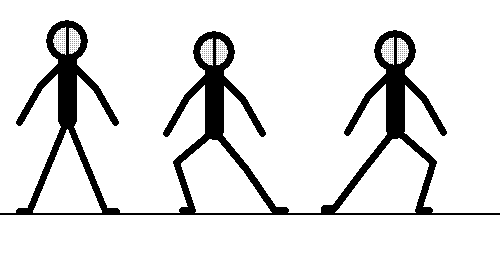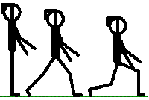Home > Training > Dynamic Stretching SwordMaster - Making Dreams Come True
Dynamic Stretching:
Important Points:
- Prior to dynamic stretching do 5-10 minutes of aerobic exercise.
- Maintain abdominal muscle tension to protect the lower back and to control trunk movement.
- Keep the feet and knees in line, to minimise excess knee pressure.
- Apply gentle forces and maintain control throughout all movements.
- Progressively extend movement range over several movement repetitions, as the muscles relax and movement range increases (muscles loosen).
- Generally complete up to 12 movement repetitions. More or less than 12 may be required depending on how the muscles and the movements feel.
- Take about 5 minutes in total for dynamic muscle stretching during Warm-up.
Special Note:
- If you need to do static stretches, as advised by a trainer or physiotherapist, do the stretches after the aerobic exercise. Keep warm while doing static stretches and repeat the stretches after training and competition.
To download the SwordMaster "Fencing Warm-up Dynamic Stretching Routine" ... download here
Dynamic Stretching Routine:

- Hold support and balance on one leg.
- Swing the other leg forwards to a comfortable height. Ensuring the trunk and lower back stays firm, do not bend (maintain abdominal tension).
- Keep the knee of your swinging leg straight when swinging forward and foot vertical (aligned with knee).
- Swing the leg backwards, ensuring that there is little movement in your back.
- Keep the knee of your swinging leg slightly bent when swinging back.
- Heal of supporting leg on the floor all the time (do not rise up onto toes).
- Exhale deeply with each forward leg swing.
- Change leg and repeat.
- Keep both hips facing forward, maintaining abdominal tension and minimising trunk/torso movement.
- Swing to a height that suits your flexibility. Forcing the leg high by swinging too hard may result in injury.

- Hold support and balance on one leg.
- Keep the supporting leg's foot turned outwards.
- Swing the free leg away from the body, keeping the toes of the free foot pointing straight upwards.
- Swing the leg back across the body, this time pointing the toes in the leg movement direction.
- Exhale deeply with each upward leg swing.
- Change leg and repeat.
- Maintain abdominal tension and minimise trunk/torso movement.
- Hold a support, stand with feet together.
- Lift the knee of one leg, high to the front.
- Rotate the knee/leg outwards.
- Return to the start position.
- Exhale deeply with each outward knee rotation.
- Change leg and repeat.
- Maintain abdominal tension and minimise trunk/torso movement.
- Take up a sprint start position, with arms straight, hands beneath shoulders, legs bent, feet side by side with weight on the balls of the feet (heels off the ground).
- Stretch the calf by pushing the heel of one foot towards the ground and then back again to the ball of the foot.
- Alternate the action with the other leg.
- Maintain abdominal tension and minimise trunk/torso movement.

- Position your feet apart at least twice the distance hip-width, toes facing forwards.
- Shoulders relaxed, head up, ensuring the spine stays long and the back doesn’t round out.
- Bend both knees a little.
- Straighten one leg, so the torso is carried sideways, weight over the bent leg, hips level back straight.
- Alternate the action by bending the straight leg and straightening the bent leg, carrying the hips and torso the other side.
- Alternate sides.
- Increase the distance between the feet as much as flexibility and comfort allow, aim for tension, not pain.

- Stand with the torso and head upright, both feet facing forwrads.
- Take a large step forward, exhale and allow the body to lower down between your legs. The toes and front knee should be aligned and in the same direction of the step. The knee should be over the instep and not too far forward, over the toes.
- Check the front and back knees are at right angles at the bottom of the step.
- Recover rearwards to the standing start position for lunge squats or recover forwards for lunge walks.
- Alternate between legs.
- Maintain abdominal tension and minimise trunk/torso movement.

- Kneeling on the floor, with the arms straight, supporting with hands on the floor, forward of the head, the back arched upwards, with the stomach pulled in. Begin to breath out, bend the arms, look straight down at the ground and allow the face to lower towards the ground so the nose nearly touches the ground.
- Looking straight down, extend the body so the head moves forwards, arms supporting and keeping the nose close to the ground.
- At full extension start to look upwards, straighten the arms and leading with the head the back arches and exhale fully.
- Begin to breath in, hold the back arch, extending the arms bending the legs, returning towards the start position. As you begin to move into the start position change from a rearwards back arch to a hunched position (upwards and stomach pulled in) completing the full inhalation when back in the start position.
- Maintain abdominal tension and minimise trunk/torso movement.
- Do more repetitions if any areas of the back are tight, but without forcing the movement.
8. Arm Swinging with Body Rotation:

- Position your feet shoulder width apart.
- Begin with both arms extended out to one side, hands at waist height torso rotated and head looking that way.
- Repeat from side to side, swinging the arms, rotating the torso and head to each side, with hands still at waist height.
- Repeat at shoulder height and then head heights.
- Reach around as far as flexibility comfortably allows - aim for tension, not pain.
9. Arm circling

- Stand with feet slightly apart, back straight.
- Swing both your arms around in circles in the vertical plane, while keeping your back still.
- Change direction and repeat.
- Maintain abdominal tension and minimise trunk/torso movement.
- If you find tightness in an area, spend more time in the area to loosen it up.